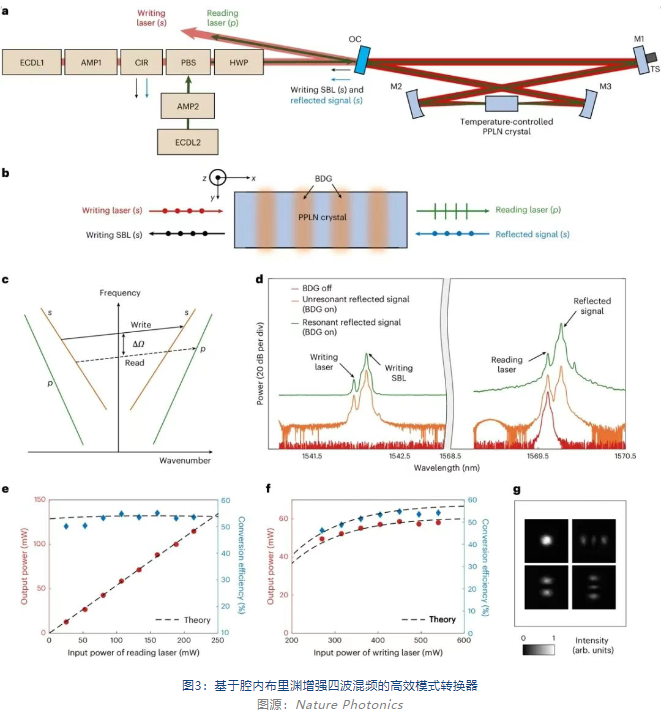04
2025
-
06
Cross-polarized stimulated Brillouin scattering empowers innovative photonic devices
Author:
Stimulated Brillouin scattering (SBS) SBS is a third-order nonlinear effect of photon-phonon interaction, which has been a hot spot in frontier research since its discovery a century ago. With its characteristics of ultra-narrow MHz linewidth, microwave-compatible GHz frequency shift, and high frequency-selective gain, it has become the core of deepening the understanding of light-matter interaction and promoting technological innovation, and has been widely used in optical atomic clocks, high-resolution spectroscopy, precision optical gyroscopes, microwave photonics, biomechanical imaging, quantum entanglement generation, and other fields.
In recent years, the trend of expanding SBS basic research and device performance by introducing more degrees of freedom and integrating other nonlinear optical phenomena has become significant: optical angular momentum modes in ring-core fibers provide new mechanisms for SBS control; multi-parameter synchronous sensing has been achieved using few-mode fiber SBS; in addition, the team also used the coupling of SBS and Kerr nonlinearity to solve the problems of thermal instability, time jitter, and self-starting of dissipative Kerr soliton combs [Nature Communications 13, 6395; Nature Communications 15, 55], making them more suitable for field deployment and practical applications.
Polarization control is another key dimension for expanding SBS applications. In theory, anisotropic materials such as lithium niobate can significantly enhance cross-polarized SBS effects, but require precise control of their complex optical, acoustic, and elastooptic orientation characteristics. Although recent studies have observed cross-polarized SBS spectral signals in lithium niobate, whether their intensity is sufficient to support device development and performance improvement remains a key scientific question.
In addition, the non-centrosymmetry of lithium niobate gives it a second-order nonlinearity several orders of magnitude stronger than the Kerr effect. Based on this, the second-order frequency comb exhibits a lower pump threshold, higher conversion efficiency, and can be extended to the visible/mid-infrared band, showing significant potential in random number generation, optical Ising machines, and precision spectroscopy. A scientific question that needs to be explored is: Can cross-polarized SBS be combined with second-order nonlinearity to further unleash the application potential of second-order frequency combs?
Recently, Nie Mingming and his collaborators from University of Electronic Science and Technology of China (UESTC) made the first attempt to solve the above two problems, systematically revealing the strong gain characteristics of cross-polarized SBS in lithium niobate crystals, and demonstrating its efficient coupling mechanism with second-order nonlinearity, thus successfully developing three innovative photonic devices. The results were published in Nature Photonics ,titled “ Cross-polarized stimulated Brillouin scattering empowered photonics 。University of Electronic Science and Technology of China Professor Nie Mingming is the first author and co-corresponding author of the paper, and Professor Shu-Wei Huang from the University of Colorado Boulder is the co-corresponding author.

Reconfigurable Brillouin Laser
Traditional Brillouin lasers have a fixed cavity length, making it difficult to achieve a wide range of matching between the Brillouin gain peak and the resonance peak. The research team used the birefringence thermo-optic effect and cross-polarized Brillouin scattering effect of lithium niobate crystals to achieve wavelength and spatial mode reconfigurable Brillouin laser phase matching at any wavelength. By adjusting the crystal temperature, the laser can be tuned in the range of 1540-1580 nm (limited by the amplifier used in the experiment), with an instantaneous linewidth as low as 0.7 Hz; benefiting from the cross-polarized Brillouin scattering effect, the signal-to-noise ratio is as high as 48 dB. This technology provides an ideal light source for optical atomic clocks, high-precision gyroscopes, and other equipment.

Brillouin-Second-Order Laser and Frequency Comb
Using the synergistic effect of cross-polarized Brillouin effect and second-order nonlinearity, near-infrared and visible dual-band lasers and frequency combs pumped by intracavity Brillouin lasers were realized for the first time. Among them, the second-harmonic conversion efficiency reaches 12%, and the frequency comb linewidth is only on the order of 1 Hz. This achievement lays the foundation for the development of microcavity optical frequency combs in the ultraviolet to mid-infrared spectral range, and can be further optimized to obtain ultra-low noise broadband soliton optical frequency combs, which are expected to promote frontier applications such as quantum sensing and optical neural networks.

Summary and Outlook
The strong gain characteristics of cross-polarized stimulated Brillouin scattering in lithium niobate, combined with its multi-physical field control capabilities such as thermo-optic and electro-optic effects, provide a new design dimension for novel light sources. With the maturity of thin-film lithium niobate photonic integration technology, it is expected that more innovative photonic devices besides the above-mentioned devices can be developed using the revealed cross-polarized stimulated Brillouin effect, realizing miniaturization and low-power operation on-chip, bringing revolutionary changes to frontier applications such as optical atomic clocks, high-precision gyroscopes, optical communication, and optical neural networks.
LATEST NEWS
2025-07-12
Hyperspectral channel density on-chip diffractive speckle spectrometer
Driven by the demand for high-performance miniature spectrometers, research on chip-scale spectrometers is continuously breaking through towards high integration, high resolution, and large bandwidth. This work proposes a silicon-based on-chip spectrometer based on cascaded disordered metasurfaces. Through various on-chip wavefront modulation mechanisms, high-spectral speckle is generated, which expands the number of spectral channels with a compact chip size, thus achieving extremely high on-chip spectral channel density and providing an effective means for achieving high-resolution, large-bandwidth spectral detection.
2025-07-14
Ultrasensitive room-temperature extreme photoelectric response achieved
This study, for the first time, achieved the control of ultra-sensitive photoelectric response optimized for room temperature conditions through electromagnetically induced potential well effects and exciton insulator phase transition characteristics.
2025-07-15
Preparation and research progress of glass scintillators for X-ray imaging
Developing suitable host materials with strong X-ray absorption coefficient, good exciton transport efficiency, low phonon energy, and high lanthanide ion solubility remains a cutting-edge research direction in the field of X-ray detection.
2025-07-16
Quantum logic gates based on single-piece gradient metasurface
In today's rapidly developing quantum information technology, realizing efficient and highly integrated quantum logic gates is one of the key challenges in the field of integrated quantum optics.
2025-07-17
Preparation and performance study of epoxy-thiol high-contrast color polymer dispersed liquid crystals
Polymer Dispersed Liquid Crystal (PDLC) is a smart material consisting of micron-sized liquid crystal droplets dispersed in a polymer matrix.

